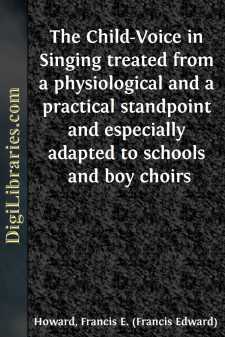Categories
- Antiques & Collectibles 13
- Architecture 36
- Art 48
- Bibles 22
- Biography & Autobiography 813
- Body, Mind & Spirit 142
- Business & Economics 28
- Children's Books 14
- Children's Fiction 11
- Computers 4
- Cooking 94
- Crafts & Hobbies 4
- Drama 346
- Education 46
- Family & Relationships 57
- Fiction 11829
- Games 19
- Gardening 17
- Health & Fitness 34
- History 1377
- House & Home 1
- Humor 147
- Juvenile Fiction 1873
- Juvenile Nonfiction 202
- Language Arts & Disciplines 88
- Law 16
- Literary Collections 686
- Literary Criticism 179
- Mathematics 13
- Medical 41
- Music 40
- Nature 179
- Non-Classifiable 1768
- Performing Arts 7
- Periodicals 1453
- Philosophy 64
- Photography 2
- Poetry 896
- Political Science 203
- Psychology 42
- Reference 154
- Religion 513
- Science 126
- Self-Help 84
- Social Science 81
- Sports & Recreation 34
- Study Aids 3
- Technology & Engineering 59
- Transportation 23
- Travel 463
- True Crime 29
The Child-Voice in Singing treated from a physiological and a practical standpoint and especially adapted to schools and boy choirs
Categories:
Description:
Excerpt
PREFACE TO THE SECOND EDITION.
One of the most encouraging signs of the growth of musical taste and understanding at the present time as regards the singing of children, is the almost unanimous acquiescence of choirmasters, supervisors, teachers, and others in the idea that children should sing softly, and avoid loud and harsh tones; and the author ventures to hope that the first edition of this book has helped, in a measure at least, to bring about this state of opinion.
It is true that for a long time the art of training children’s voices has been well understood by choirmasters of vested choirs, and by many others, but its basis was purely empirical.
Something more, however, than the dictum of individual taste and judgment is needed to convince the educators of our schools of the wisdom of any departure from established customs and practices. The primary end, then, of the author has been to show a scientific basis for the use of what is herein called the head-voice of the child, and to adduce, from a study of the anatomy and physiology of the larynx and vocal organs, safe principles for the guidance of those who teach children to sing.
The conditions under which music is taught in schools call for an appeal to the understanding first, and taste afterward. These conditions are:
First, the actual teaching of music is done by class-room or grade teachers. The special teacher, who usually supervises also, visits each room, it may be as often as once a week, but in most towns and cities not oftener than once in three or four weeks. At any rate the class form their ideals and habits from the daily lessons, which are given by their grade teacher.
Second, these teachers in the great majority of cases acquire their knowledge of music through teaching it, and must also, it can easily be understood, develop a sense of discrimination in musical matters in the same way. There is a strong natural tendency in the school-rooms to emphasize the teaching of music, or teaching about music, as contrasted with actual singing. The importance of using the voice properly will not suggest itself to many teachers.
It is necessary, then, that this, which is the essence of all instruction in vocal music, should be brought to the attention of the vast army of instructors in our public schools in as convincing a way as is possible. Now the best, and in fact the only way to secure the assent of our educators to a new idea in school work, is to prove its truth. “It is useless to dispute about tastes,” and so the less said about harsh tone to a teacher accustomed to hear it daily, and to like it, the better; but prove to this teacher that the harsh tone is physically hurtful to the child, and that for physiological reasons the voice should be used softly and gently, and you have won a convert, one, too, who will quickly recognize the æsthetic phase of the change in voice use. The author knows from observation and experience that children in the public schools can, under existing conditions, be taught good habits of voice use....


